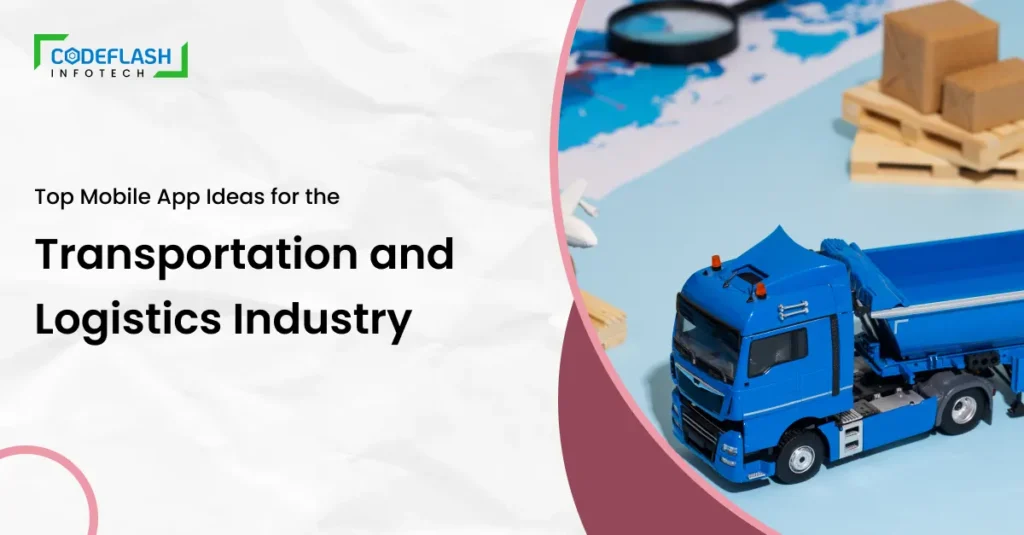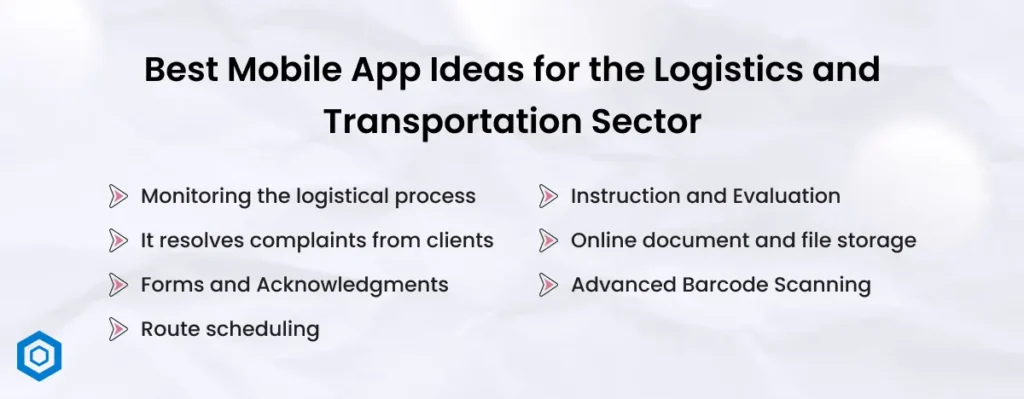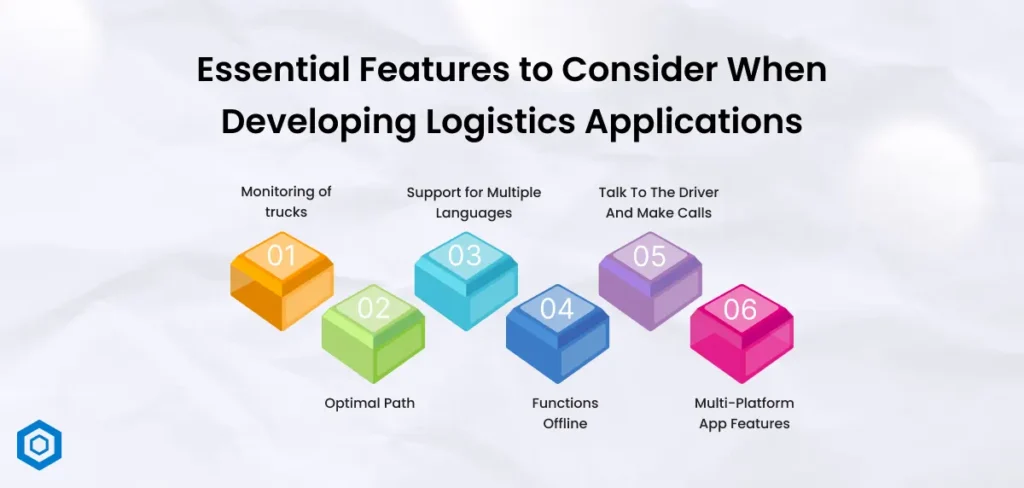
Top Mobile App Ideas for Logistics companies in 2024
24 MAY
International trade is growing stronger as the global logistics sector develops relentlessly. Your transportation company might benefit significantly from an efficient logistics app ideas in such a situation. Post-COVID, logistics faced a brief slump. But by 2027, it’s set to surge, hitting a 13.7 billion euro global market value.
Mobile apps for logistics manage supply chains more effectively. Using these applications, You can monitor truck spaces, warehouse statuses, location monitoring, and other features.
You may develop your own a logistics and transportation app from scratch to make things more regulated and effective. While raising expenses, proper optimization can favor the productivity and efficiency of a logistics operation.
The main factor that makes logistics competitive is delivery speed. Every development and advancement in warehousing and transportation aims to shorten delivery times and enhance shipping and storage security. This blog provides an overview of Top Mobile App Ideas for the Transportation and Logistics Industry.
What are the benefits of having a mobile app for your logistics company?
These industries are poised for exciting growth as innovation and cutting-edge technology transform their futures. This industry’s future may be accurately predicted using all the anticipated data and insights.
By 2027, the value of the logistics sector supporting global commerce is expected to surpass 13.7 billion euros, based on data and information provided by Statista on transportation and logistics.
According to Mordor Intelligence’s e-commerce industry study, the market size is expected to reach USD 16.24 trillion by 2028, rising at a compound annual growth rate (CAGR) of 15.80% during the forecast period (2023-2028).
According to Market Research Future’s global logistics overview, the logistics sector is predicted to develop at a compound annual growth rate (CAGR) of 6.80%, or USD 16,01,196.16 million, by 2030.
By 2023, half of the world’s product-focused businesses will have invested in real-time transportation visibility solutions, according to Gartner projections.

Best Mobile App Ideas for the Logistics and Transportation Sector
- Monitoring the logistical process
A logistics monitoring software might be helpful if your company system, ERP, or WMS offers a partial picture of shipment and delivery date.Link tracking solution provides real-time tracking of shipments and deliveries through an online portal or cloud-based mobile application. From pick-up to delivery, you will be aware of the whereabouts of every item you order because of end-to-end tracking.
As the need to pay more attention to ecological concerns grows, carbon monitoring can assist you in identifying areas where businesses can improve their environmental effect. Furthermore, you can promptly detect and fix issues related to notifications and alerts.
A crucial position in every transportation firm is dispatch. It’s also among the most tiresome. To ensure that everything is completed, knowing which driver is working on which task is crucial. Still, there’s a lot of space for misunderstanding. This is especially true given that dispatch is at the office and drivers are on the road.
This is an additional issue that can be resolved with Logistics application development solutions. Numerous smartphone apps are available, tailored especially for drivers.
A few well-known examples are “Driver Dispatch” and “Dispatch Anywhere for Drivers.” You and your drivers can monitor who is bringing what and where with the help of these applications. From anywhere in the world, everyone has access to the same information. This reduces ambiguity and confusion on the roads and in the workplace.
- It resolves complaints from clients.
You will constantly need to address issues since the world is not flawless. For this reason, if you want to deliver exceptional customer service, you need to respond quickly to problems and find solutions. When clients contact you via several methods, staying on top of everything can be challenging.Zendesk uses a single shared inbox across all channels to give users a 360-degree picture of client concerns. Zendesk facilitates problem-solving communication between you, your staff, and your clients.
The analytics and reporting tools that show patterns in problems so you can spot chances for company improvement are especially appealing to us. KPIs may also evaluate team performance and pinpoint areas needing training.
Building and maintaining customer interactions via mobile collaboration will be simple if you use the app.
- Forms and Acknowledgments
There are other ways that mobile apps reduce paperwork besides dispatch. Forms are a big part of the delivery industry. These forms keep track of almost everything, even where things were dropped off and picked up.Despite being accurate records, these forms are difficult to maintain, organized, and readily available. They must then be returned to the office so that they may be filed. Because the most recent forms have yet to be returned or entered, reports are thus constantly out of date.
You can produce digital documents using several different smartphone apps. Then, using the app, these papers may be accessed and completed on any mobile device. After that, they may be posted right away.
No more waiting for the driver to return to complete the paperwork, and no more drivers shoving each other with clipboards and pencils. Customers can plan deliveries, get quotations, and other services, and delivery and dispatch businesses can develop customer service portals and applications. Using Bringg API is one instance of a customer portal for delivery businesses.
- Advanced Barcode Scanning
When you are in a hurry, you need equipment and software development that you can rely on. Time is wasted on barcode scanners that malfunction in less-than-optimal circumstances.You can scan barcodes with Scandit even if they are hard to read due to dim lighting, broken labels, or unusual barcodes. Furthermore, you may improve your current systems by incorporating Scandit into online or mobile applications.
- Route scheduling
Google Maps is a popular app for phones. However, they frequently only offer trip routes; they need to consider if the roads are truck-friendly, not provide any feedback information.You may also add features to compare the route that is driven and the planned path. Using this post-trip study, you may assess operational and fuel expenses to determine the most economical path for your next travels.
Customer service is enhanced by the app’s real-time delivery ETAs that depend on road conditions.
- Instruction and Evaluation
Before taking to the road alone, drivers frequently ride with a corporate driver with more expertise. They can pick up the skills this way. Additionally, this is when employers often evaluate recent hires’ abilities.To design tests and quizzes, you may use various mobile apps. You may frequently rate test takers and contrast their outcomes with those of others. Using such an app in your business might be beneficial in many ways. It enables you to maintain the interest of both novice and seasoned drivers. You can also use it to reward drivers who score highly.
- Online document and file storage
Since working remotely has become essential, we’ve all made system adjustments to facilitate collaboration. For instance, several firms have successfully stored papers and data online using Microsoft Teams and SharePoint. Alternatively, it would help if you use Evernote instead of Microsoft.Evernote is one of the best apps for keeping important papers, pictures, and data organized. With voice recordings, you may take essential notes while you’re away from your computer or too busy to take the time to write them down. Perfect for hurrying from your workstation to the warehouse or while on the go.
The free software will significantly increase planner productivity and simplify managing documents on the road.

Essential Features to Consider When Developing Logistics Applications
Here is a list of some crucial elements for developing logistics apps:
- Monitoring of trucks
Apps give vehicle location information using GPS location. Additionally, this smartphone system facilitates vehicle tracking, optimizes product delivery, and provides comprehensive cargo details.A program stores the data transmitted by truck GPS units and shows the GPS coordinates transmitted by the sensors on a map.
It was also developed with the help of the Qt framework, JavaScript, C++, QML, and the Kalman filter, which helps to increase GPS location accuracy.
- Optimal Path
The logistics app’s best route feature assists in streamlining the delivery process by determining the most economical route for moving cargo. It considers variables like distance, traffic, and delivery time, ensuring that drivers take the quickest and smoothest route possible to save time and money. - Support for Multiple Languages
Making snap judgments may be challenging when there are misunderstandings and language difficulties.A multilingual application for logistics can draw in more clients and boost customer loyalty.
- Functions Offline
Occasionally, there are issues with the internet connection. Users may read reports and enter data without a network connection using an offline mobile app. - Talk To The Driver And Make Calls
The integrated calling and messaging functionalities facilitate communication between drivers, shippers, and management.Deloping a Logistics management software can change routes in the event of mishaps or malfunctions. The consumer can obtain the required delivery details from the driver.
- Multi-Platform App Features
Without UI changes, a cross-platform logistics program may run on desktop and mobile platforms such as Windows, Android, and iOS. Users may choose the most convenient manner to utilize the app from various available options.
Conclusion
In conclusion, there is a great deal of room for innovation in the logistics and transportation sector through mobile app development. The concepts discussed in this blog offer an overview of how technology may revolutionize business processes by increasing productivity, optimizing workflows, and promoting customer satisfaction. Mobile apps provide companies with always-before-seen options to stay competitive and meet changing market expectations. These opportunities may be used for anything from improving last-mile delivery with on-demand services to reinventing freight management with digital platforms or optimizing route planning with navigation applications.
Adopting these mobile app concepts can open doors for profitable expansion, sustainable growth, and, eventually, a more integrated and effective transportation and logistics ecosystem as the sector develops.





